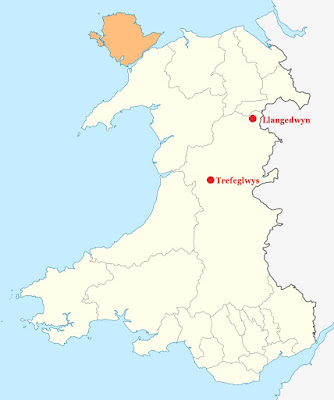Plotting Camlan: Letters from the Dead
Sixth in Evan Evans’s list of the Seven who escaped from Camlan is “Derfel the Strong from his strength”. Derfel is an elusive character, completely absent from the Triads and the earliest stratum of Welsh Arthurian poetry.
Derfel Gadarn (Derfel the Mighty) is remembered by the later Welsh poets as fighting at Camlan. After the carnage of this battle he turned his back on warfare and entered the religious life, studying at Llantwit. He is said to have become a hermit and founded the church at Lllanderfel, Penllyn, near Bala, in the early 6th century, recorded as the “Old Abbey” in 1291. The churchyard is curvilinear indicating its early Celtic Christian beginnings. The church was extensively rebuilt around 1500. About 350m north-west of St Derfel's Church is Ffynnon Derfel (Derfel's Well).
On the hillside of Mynydd Maen in Gwent, South-East Wales, a shrine was also dedicated to him. He is said to have moved to the monastery at Bardsey Island taking up the position of Abbot, succeeding St Cadfan, his cousin. Derfel is said to have died at Bardsey in 660 AD.
Llanderfel is perhaps best remembered today for the story of the wooden image of the Saint that was sent to London in 1538 and used for the execution of John Forest at Smithfield. Forest had been confessor to Queen Catherine of Aragon, the first wife of King Henry VIII, and refused to acknowledge the King as head of the church. Forest was burned to death for heresy, roasted over the wooden statue of St Derfel. This act was said to be a fulfilment of the prophecy that the statue would one day burn down a forest.
Originally the Saint’s statue at Llandderfel portrayed him as an armed warrior, not a monk, sat upon a horse, some say stag which was a common companion for many of the Welsh saints. Before the Reformation, hundreds of pilgrims are said to have visited the church to see the statue every 5th April, St Derfel’s feast day.
 |
| St Derfel's Horse |
After special pleading by the local people the red stag known as the “Horse of Derfel” was permitted to remain at Llanderfel church, where it can still be seen today in the north porch, looking worse for wear after its decapitation in 1760 on the orders of the Dean.
The Brother of Arthur
According to the late Welsh genealogical tract Bonedd y Saint, Derfel is listed as a son of the legendary king of Brittany Hywel Mawr (Hoel the Great). In Welsh tradition Derfel arrived with St Cadfan and twelve other saints from either Brittany or Llanilltud Fawr; other tracts claim he was brother to St Tudwal and St Arthfael (Armel).
Barber and Pykitt (Journey to Avalon: Final Discovery of King Arthur), argue that St Armel was actually the name King Arthur took after the battle of Camlan. Arthur, like many of the survivors of Camlan, is said to have renounced the warrior-life and turned to religion becoming a Saint; he went into exile in Brittany founding churches at Plouarzel, St Armel-des-Boschaux and Ploermel. Barber and Pykitt concluded that Arthur did not die at Camlan but simply disappeared, leaving his fate, and his grave, unknown to the Britons.
St Armel’s shrine can still be seen at St Armel-des-Boschaux, which, in keeping with the wonder of Arthur’s grave, is of course empty. However, there is no Breton connection between St Armel and King Arthur.
The location of Llanderfel is significant in our search for Camlan as it is in the same region (Bala) where Morfran (Afagddu) came from. Yet if the date of Derfel’s death is correct at 660, he is certainly too late to have fought at Camlan in 537.
The Brother of Arthur
According to the late Welsh genealogical tract Bonedd y Saint, Derfel is listed as a son of the legendary king of Brittany Hywel Mawr (Hoel the Great). In Welsh tradition Derfel arrived with St Cadfan and twelve other saints from either Brittany or Llanilltud Fawr; other tracts claim he was brother to St Tudwal and St Arthfael (Armel).
Barber and Pykitt (Journey to Avalon: Final Discovery of King Arthur), argue that St Armel was actually the name King Arthur took after the battle of Camlan. Arthur, like many of the survivors of Camlan, is said to have renounced the warrior-life and turned to religion becoming a Saint; he went into exile in Brittany founding churches at Plouarzel, St Armel-des-Boschaux and Ploermel. Barber and Pykitt concluded that Arthur did not die at Camlan but simply disappeared, leaving his fate, and his grave, unknown to the Britons.
St Armel’s shrine can still be seen at St Armel-des-Boschaux, which, in keeping with the wonder of Arthur’s grave, is of course empty. However, there is no Breton connection between St Armel and King Arthur.
The location of Llanderfel is significant in our search for Camlan as it is in the same region (Bala) where Morfran (Afagddu) came from. Yet if the date of Derfel’s death is correct at 660, he is certainly too late to have fought at Camlan in 537.
*
We have now looked at six of the survivors from Evan Evans’s list of the seven who escaped Camlan. Last is “Geneid the Tall, from his speed” who has defied identification.
However, Peter Bartrum has suggest that the name “Geneid Hir” is derived from Eueyd Hir or Euehyd Hir, a name from the Second Branch of the Mabinogi as one of the seven chieftains left in Britain by Brân when he took the forces of the Island of the Mighty to Ireland.
Next: Medrawd: Fallen Hero?
* * *














